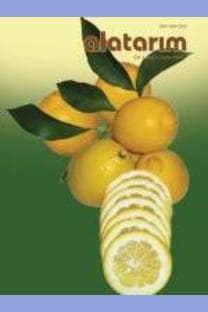Dihaploidizasyon yöntemiyle geliştirilen hibrit kavun genotiplerinin cam sera koşullarında verim ve bazı agronomik özelliklerinin saptanması
Dünya kavun üretiminde Çin’in ardından ikinci sırada yer alan ülkemizde, ağırlıklı olarak Cucumis melo var. inodorus grubuna giren ve açıkta yetiştirilen çeşitler kullanılmaktadır. Akdeniz sahil şeridinde yoğunlaşan örtü altı yetiştiriciliğinde ise C. melo L. var. cantalupensis grubuna giren, erkenci, küçük meyveli ve aromalı kantalop tipi kavunlar tercih edilmekte ve üretim çoğunlukla yurtdışından ithal edilen hibrit çeşitlerle yapılmaktadır. Çalışmada, dihaploidizasyon yöntemiyle elde edilmiş, Fusarium oxysporum f.sp. melonis’in 0 ve 1 numaralı ırklarına dayanıklı C. melo var. cantalupensis grubuna giren, 7 adet yerli ümitvar hibrit kavun genotipinin verim ve bazı bitkisel özellikleri ile birlikte meyve kalite kriterleri test edilmiştir. Bu amaçla genotipler, üç farklı şahit Fı çeşit (Galia Fı, Polidor Fı ve Makdimon Fı) ile sera koşullarında karşılaştırılmıştır. Araştırma sonucunda, elde edilen Fı hibritlerden bazıları hibrit çeşitlere yakın ve hatta bazı özelliklerce onlardan daha üstün performans göstermişlerdir
Anahtar Kelimeler:
kavun, Cucumis melo, örtü altı yetiştiriciliği, bitki yetiştirme sistemleri, kültür çeşitleri, Akdeniz Bölgesi, Türkiye, meyve kalitesi, genotip, hibritler, tarımsal özellikler
Determination of yield and some agronomic characteristics of melon cultivars developed by dihaploidization technique in glasshouse conditions
Melon cultivars belonging to Cucumis melo var. inodorus group are mainly produced at open field in our country which is the second melon producer after China. The early- yielded, small fruited and odourous cultivars are preferred for protected cultivation at the coastal part of Mediterranean region which are members of C. melo var. cantalupensis, however the production is mostly conducted with imported foreign hybrid cultivars. In this study, 7 promising hybrid cultivars resistant to race 0 and 1 of Fusarium oxysporum ssp. melonis belonging to C.melo var. cantalupensis group, obtained by dihaploidization technique were tested for yield, some plant characteristics and fruit quality criterias. For this aim, the genotypes were compared to three different control Fı cultivars (Galia Fı, Polidor Fı and Makdimon Fı) in greenhouse condition. According to the results, the promising Fı hybrids obtained by this research showed similar, even higher performance for some characters than Fı hybrids.
Keywords:
melons, Cucumis melo, protected cultivation, cropping systems, cultivars, Mediterranean Region, Turkey, fruit quality, genotypes, hybrids, agronomic characteristics,
___
- Anonim, 2004. FAOSTAT. Statistic Database. http://faostat.fao.org/
- Glala, A.A., Omar, N.M., El-Shinawy, M.Z., Helal, R.M., 2002. Producing Some New Egyptian Melon Hybrids: II-Growth Vigor, Earliness and Yield Performance of Some New Promising Fı Hybrids. Egyptian Journal of Horticulture, 29 (3/4), 421-439.
- Nadpuri, K. S., Singh, S., Lal, T., 1974. Study on the Comperative Performance of F1 Hybrids and Their Parents in Muskmelon. Punjab Agric. Univ. J. Res., 11, 230.
- Nunes, G.H. de S, Santos Junior, J.J.dos, Andrade, F.V., Bezere Neto, F., Almedia, A.H.B.de; Medeiros, D.C.de, 2004. Yield and Quality Aspect of Melon Hybrids Grown in Agropolo Mossoro-Assu. Horticultura Brasilieira, 22 (4), 744-747.
- Robinson, R.W., Deckers-Walters, D.S., 1997. Cucurbits. CAB International Wallingford, pp 226.
- Sarı, N., Ekiz, H., Yücel, S., Yetişir, H., Abak, K., 1999. Kavunda Dihaploidizasyon Yöntemiyle Örtüaltı Tarımına Uygun ve Fusarium oxysporum f.sp.melonis’e Dayanıklı Hatların Geliştirilmesi. Türkiye III. Ulusal Bahçe Bitkileri Kongresi, 14-17 Eylül 1999,Ankara, 498-503.
- Sarı, N., Yetişir, H., Ekbiç, E., Gök, P., 2002a. Kavunlarda Bitki Boyu ve Gövde Çapı Üzerine Heterozis Etkisi. 4. Sebze Tarımı Sempozyumu Bildiri Kitabı, Uludağ Üniversitesi, Ziraat Fakültesi, Bahçe Bitkileri Bölümü, 17- 20 Eylül 2002, Bursa. ss: 229,1-10.
- Sarı, N., Yetişir, H., 2002b. Some Agronomical Characteristics of Doubled Haploid Lines Produced by Irradiated Pollen Technique and Parental Diploid Genotypes in Melon. Turkish Journal of Agric. and Forestry, 26, 311-317.
- ShouDong, G., Hui, Z., XinFu, L., 2004. A New Muskmelon Fı Hybrid – “Zaohuanghou”.China Vegetables (No.4), 28-29.
- Tonfoni, R., Stoppelli, G., 2003. Comparisons of Melon Varieties. Informatore Agrario, 59 (49),37-43.
- Zuang, H., 1982. La Fertilization des Cultures Legumieres. CTIFL Publ., Paris, 391.
- ISSN: 1304-2653
- Başlangıç: 2015
- Yayıncı: Alata Bahçe Kültürleri Araştırma Enstitüsü
Sayıdaki Diğer Makaleler
Nebahat SARI, İLKNUR SOLMAZ, HÜSNÜ ÜNLÜ
Güçer KAFA, Önder TUZCU, TURGUT YEŞİLOĞLU
Serkan AKCAN, Salih KAFKAS, MEHMET SÜTYEMEZ, YAŞAR AKÇA, SİNAN ETİ, NURGÜL FETİYE TÜREMİŞ
Modifiye atmosferde muhafazanın Çengelköy hıyar çeşidinde meyve kalitesi üzerine etkileri
FERHAN KÜÇÜKBASMACI SABIR, İ. Tayfun AĞAR
İzmir'de sözleşmeli ve sözleşmesiz domates üretiminin karşılaştırmalı ekonomik analizi
